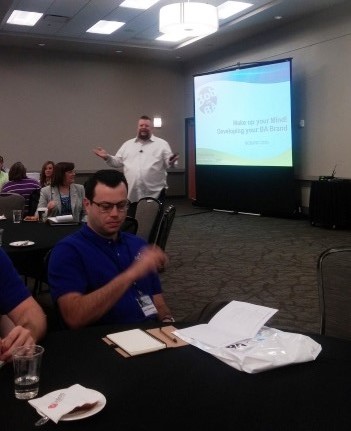What is your Business Analyst Brand?
I give complete credit for this article to Bob “the BA” Prentiss. I had to privilege and pleasure of hearing his keynote address to the Southwest Ohio Business Analysis Regional Conference (SOBARC), hosted by Cincinnati IIBA Chapter. It was a very entertaining and thought provoking presentation. So I invite you to consider “What is your BA Brand?”
Did you know that you had a brand? What is a brand? Many think it is a marketing tool that companies use to sell their products and services in the marketplace. Absolutely correct; don’t you think that Apple, Google, B2T Training, The Solarity Group, Bob the BA, and Watermark Learning have brands?
However did you know that you, an individual Business Analyst in your company, have a brand? What is your brand? The more important question, what do you want your brand to be?
These are the questions that Bob “the BA” Prentiss asked us at the recently concluded SOBARC conference during a very inspirational keynote address. He gave excellent tips on how to brand yourself and make yourself distinguishable among the business analysts in your organization.


One thing that impressed me during Bob’s presentation is that he never went up on stage; he delivered his entire presentation walking among the audience. When he asked the audience “What do you think about Bob the BA?” He received the joking answer “pushy”. He did not get upset, but rather took a negative and turned into a positive. He continued to discuss how we from time to time have to change the mindset and the way of thinking of some of our business and technical stakeholders to create that “shared vision”. Ending that thought with “sometimes pushy, yes I can accept that because sometimes that is what it takes to get the job done”.
So, did you know that you create your brand every day at work? So what is your brand, and what do you want it to be? As ‘Bob the BA’ puts it “Be consistent, creative, memorable, have a signature that ‘you’ cocktail…” is how you develop a great brand.
So are you consistent?
Do you consistently deliver your work deliverables on time? Early? Late? Do you “own” your work assignments? How do you want to be remembered? What is the impact to your projects and service work? Can your teammates count on you to deliver? Do you communicate to your Project Manager and other team members to properly set expectations? How is the quality of your work? That will be remembered, possibly most of all. Do you take extra time to put the professional touches, add that craftsmanship, on your work before sharing it with the team? Just a word of caution, don’t allow the professional touches make your work consistently late.
Are you creative?
Do you just take a template for an artifact and fill it out? Have you ever added something to a template? Have you ever questioned why a particular section is in the template, or challenged that it should not be in that place or in the template at all? How creative are you on your business analysis techniques? Do you just do typical individual or group interviews (discussions with business stakeholders)? When is the last time you facilitated a brainstorming or wireframing session?
Are you memorable?
Six months after a project ends, will the business stakeholders remember you as the business analyst that worked on that project? What will they remember about you? Will they say “typical BA”, “nothing special”, “shoddy workmanship”; or will they say “excellent BA”, “knows their stuff”, “kept me engaged”, “enjoyed working with them” or other favorable feedback on your work. How will you be remembered?
Are you passionate?
Do you enjoy your work and does it show in your daily work? Are you passionate about the BA role? Do you look forward to going to work every day? Will feedback come back that you’re a passionate BA? Do you go that extra mile for your business stakeholders and other team members? How will you be remembered?
The Message
I recently attended an IIBA meeting in Dayton, Ohio entitled “Craftsmanship for Analysts” by Terry Wiegmann. The message was the same as Bob the BA’s message: “Cocktail your brand”. Continuously improve, but stay consistent in your message and work. I don’t intend to take anything, or keep anyone, from seeing either of these professionals speak. In fact, I encourage anyone that has the opportunity to go participate in any of Bob or Terry’s presentations, do so; you will receive a lot from the experience.
Did this post get you thinking about your brand, and your daily work? How will you change to make your brand what you want it to be?
Don’t forget to leave your comments below.



